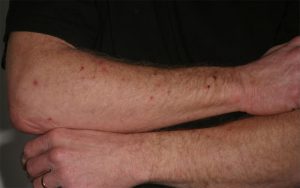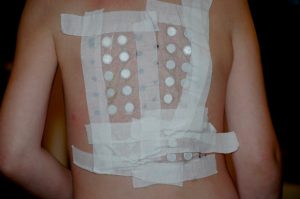Contact dermatitis is a form of eczema that occurs when your skin comes in contact with certain metals used in jewelry, some fragrances, plants, cosmetics, and soaps. It usually starts off as a rash and causes a reaction on the surface of the skin.
Contact dermatitis is not a life-threatening condition and the reaction usually goes away a few weeks later when the substance that’s causing it is no more in contact with the skin. However, it can relapse on using the substance/jewelry again. The rash is generally noticed near sensitive areas like around the eyes, nose or mouth. Self-care tips like soothing the irritated area with cold wet compresses, and applying anti-itch creams can help treat the condition at home.
SYMPTOMS
Contact dermatitis is a condition where the symptoms usually depend on how sensitive your skin is to substances. There are various substances that can cause an allergic reaction as they take away the surface shielding oils from your skin.
Some of the symptoms you may notice are:
- Blisters that may crust or ooze fluid
- Tenderness at the site of contact, accompanied by swelling and burning.
- Severe itching
- A red rash
- Cracked and scaly skin.
Usually, the symptoms subside on their own with some self-care. However, you should call the doctor if the symptoms get worse such as:
The rash becomes painful, severe and widespread.
- The rash is very uncomfortable that you cannot sleep at night and cannot work during the daytime.
- The rash doesn’t heal within three weeks.
- When the rash is so much worse than you have to hide it in public.
- The rash appears on your face or genitals.
Immediate medical attention is needed in the following conditions:
- You feel the rash has damaged the mucous lining of the mouth and has spread to the digestive tract.
- When your skin becomes infected and you have pus oozing out from the blisters.
- Your eyes are red and swollen and the nose is inflamed.
- Your lungs feel painful by inhaling an allergen.
CAUSES

Contact dermatitis is caused by an allergen or an irritant that you are exposed to, that causes damage to the external layer of the skin. In other cases these allergens also may trigger your immune system to overreact in a way that it shouldn’t. As a result, the skin gets affected with sudden rashes that can get severe at times.
Irritant Contact Dermatitis:
This type of contact dermatitis occurs when the substance you come in contact with, damages the outer layer of the skin. This is the most common type of non-allergic reaction. A single exposure to a strong irritant may be enough to cause the reaction. However, some people may develop tolerance to an irritant over time. Few common irritants include:
- Bleach and detergents
- Rubbing alcohol
- Shampoos
- Solvents
- Ache
- Sweet Syndrome
- Sawdust and wood dust
- Fertilizers and pesticides
- Plants
Allergic Contact Dermatitis:
Allergic contact dermatitis occurs when your skin comes in contact with an allergen. Allergen is a substance that you are sensitive to and it produces an immune reaction when your skin comes in contact with it. The area that comes in contact with the allergen is affected.
However, sometimes an allergen may enter your body through an oral route, and cause systemic contact dermatitis. For example; some people are allergic to certain food items, flavors, medicines, or substances used in medical and dental procedures. Examples of some common allergens that cause allergic contact dermatitis include:
- Medication such as antibiotics.
- An ingredient mostly used in mouthwash, perfumes, flavorings and cosmetics.
- Nickel mostly found in belts, jewelry, and other accessories.
- Formaldehyde mostly found in preservatives, disinfectant, and clothing.
- Products used for personal care including hairstyles, body washes, deodorants, cosmetics, and nail polish.
- Plants such as mango and poison ivy, since they contain a highly allergic substance called urushiol.
There are some products that may cause allergic contact dermatitis, which is also called photoallergic contact dermatitis. Labels on the back of the products clearly warn if the products cause an allergic reaction with sun exposure. Make sure to read the back label before using the products.
Children may also develop contact dermatitis due to the same causes. Some other causes of contact dermatitis in children include prolonged exposure to wet diapers, baby wipes, sunscreen, clothing that have dyes or have snaps. Since a baby’s skin is very sensitive, extra care should be taken to ensure to keep the irritants and allergens out of contact.
Contact dermatitis also develops depending on the type of job you do and hobbies you pursue on a regular basis. People who are at higher risk of contact dermatitis include:
- Metal workers
- Construction workers
- Healthcare and dental employees
- Auto mechanics
- Cosmetologists
- Swimmers or scuba divers who wear rubber masks and goggles
- Gardeners and farmers
- People who do cleaning work for a living
DIAGNOSIS

The doctor will ask you some questions regarding the allergic reactions and ask you to identify what substances trigger the reaction. He may ask you about the signs and symptoms and try to map a pattern between the exposure and the intensity of the rash.
Patch testing: Patch testing is done to identify the allergen causing the reaction. This is useful if the substance causing the reaction is unknown or the rash is persistent. Small amounts of allergens are applied to adhesive patches which are then placed on your skin for a duration of 2-3 days. The doctor will ask you to keep your back dry. Skin reactions caused under the patches are observed to identify the allergen. The doctor may also do further testing if necessary. Your skin will be examined by the doctor after two days because most of the allergic reaction will take this long to develop.
Repeat open application test (ROAT): Testing for irritants is a little tricky since it’s really hard to tell in some product, which ingredients might irritate your skin. This test is particularly useful in such cases, especially for the products you use on sensitive and cosmetically important areas like your face, eyes etc. You can use this test at home to test your cosmetics. ROAT method of testing involves reapplication of the same product on the same area of your skin twice daily. This routine is to be repeated for 5-10 days to see how your skin reacts.
TREATMENT

Home care mostly helps subside the irritation and allergic reactions in contact dermatitis. However, if the signs and symptoms persist then your dermatologist doctormay prescribe you some medications which include:
- Creams or ointments: Creams and ointments, when applied on the site of irritation, help soothe your skin. The doctor will prescribe some steroid ointments and creams which can be applied twice daily for upto 4 weeks.
- Oral medications: Your doctor may prescribe oral medicines such as corticosteroids to reduce inflammation, antihistamines for itching or antibiotics to fight a bacterial infection.
PREVENTION
Contact dermatitis can be prevented by the following steps:
- Stay away from irritants and allergens. Watch out for substances that irritate your skin or cause an allergic reaction.
- Immediately clean skin. When you come in contact with an allergen, a rash appears, immediately wash your skin with mild, fragrance-free soap and warm water. Rinse completely. Remove and wash any clothing that may have come in contact with the plant allergen such as poison ivy.
- During household cleaning use protective clothing or gloves. Use Face masks, goggles, gloves, and other protective items to avoid contact with irritants including household cleansers.
- For metal allergies, use an iron-on patch to cover metal fasteners. This can help you avoid a reaction to jean snaps when they come in contact with your skin for example.
Use a cream or gel as a barrier. These creams and gels help provide a protective barrier for your skin. - Apply moisturizer regularly. Moisturizing your skin regularly can restore your skin’s outermost layer and keep it healthy.
- Be careful around pets. Certain allergens can cling to pet hairs then be spread to people. Example, poison ivy can cling to pets and spread around.
MANAGEMENT
You can try some of these methods to reduce itching and soothe inflamed skin at home.
- Stay away from the irritant or allergen. Identify the irritant causing your rash and stay away from it. The doctor will provide you with a list of products that may contain the substance that causes irritation and ask you to avoid them. You may replace them with products that are free of the substance that affects you.
- You might be allergic to a certain metal found in your jewellery. You can still wear it by lining the inside of the metal with clear tape, or paint it with clear nail polish, so as to create a barrier between the jewellery and your skin. This way your skin does not come in contact with the metal.
- Apply an anti-itch cream or lotion to the affected area. Over the counter creams containing 1% hydrocortisone can be applied temporarily on the affected area to relieve your itch. Calamine lotion works well too to soothe your rash.
- Take oral anti-itch medications. If the itching is worse, oral medications containing corticosteroid or antihistamine, such as diphenhydramine (Benadryl), will help relieve your itch.
- Apply cool, wet compresses. Wet soft washcloths and press them against the rash for 30 minutes to soothe your skin. Repeat frequently if irritation is severe.
- Avoid scratching. Scratching makes the rash worse. Keep your nails trimmed and you might also cover the itchy area with a dressing to avoid scratching.
- Soak in a moisturizing and cool bath. Sprinkle the bath water with baking soda or an oatmeal-based bath product. It helps soothe the contact dermatitis.
- Moisture and protect your hands. After washing your hands, rinse them and dry them properly. Apply moisturizer liberally to keep them soft. Wear protective gloves while working with irritants and allergens.
- If you have contact dermatitis, it’s time you find a good dermatologist to examine your condition, if home care doesn’t help you relieve the symptoms.
Since contact dermatitis is a form of eczema. It’s important to know other types of eczema in order to be able to differentiate between them and get the right treatment. Other types of eczema are:
- Atopic eczema: General type of eczema that is mostly hereditary, it runs in families. It is mostly associated with hay-fever and asthma.
- Discoid eczema: eczema occurs as circular or oval patches on the skin.
- Varicose eczema: Mostly affects the lower legs due to improper blood flow through the veins.


















